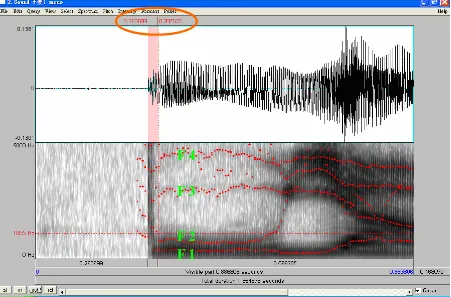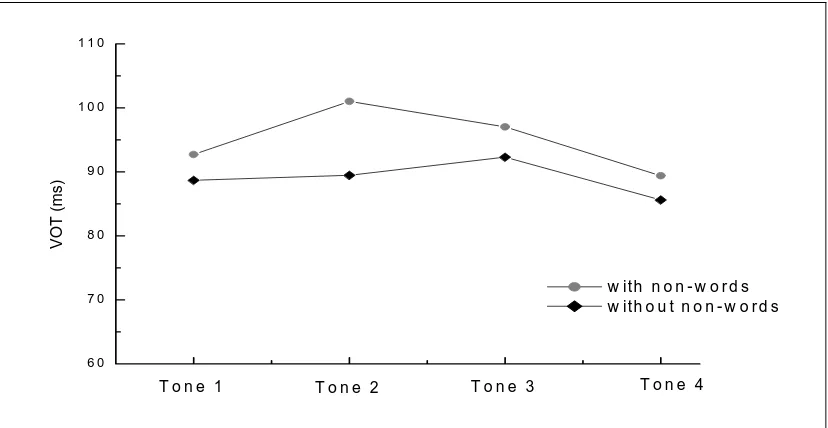聲調對嗓音起始時間的影響:以國語和客語為研究對象
Tonal effects on voice onset time: Stops in Mandarin and Hakka
彭瑞鳳 Jui-Feng Peng
陳麗美 Li-mei Chen
林依雲 Yi-Yun Lin
國立成功大學外國語文學系(所)
Department of Foreign Languages & Literature National Cheng Kung University
leemay@mail.ncku.edu.tw
Abstract
This study examines the influence of lexical tone upon voice onset time (VOT) in Mandarin and Hakka. Examination of VOT values for Mandarin and Hakka word-initial stops /p, t, k, ph, th, kh/ followed by three vowels /i, u, a/ in different
lexical tones revealed that lexical tone has a significant influence on the VOTs. The result is important because it suggests that future studies should take its influence into account when studying VOT values for stops in tonal languages. In Mandarin, stops’ VOTs, ordering from the longest to the shortest, are in Tone 2, Tone 3, Tone 1, and Tone 4: this sequence is the same as Liu, Ng, Wan, Wang, and Zhang’s (2008) [1] results. However, later it was found that the sequence results from the existence of non-words. Because in order to produce non-words correctly, participants tended to pronounce them at a lower speed, especially those in Tone 2. Therefore, we further examined the data without non-words, in which no clear sequence had been found. For Hakka, Post hoc tests (Scheffe) show that aspirated stops in Tones 4 and 8 have significantly shorter VOT values than they have in other tones.
Keywords: Voice onset time, Mandarin tones, Hakka stops, Mandarin stops
1. Introduction
The aim of this paper is to explore whether lexical tones influence the VOT values for word-initial stops. This issue is important because VOT is considered as a reliable phonetic feature to differentiate consonant stops ([2], [3], [4], [5], [6], [7]) and recently it has been used to study the language production of patients with language deficits or disorders ([8], [9]). Among the languages being investigated, some are tone languages, i.e. Mandarin, Cantonese, and Taiwanese. In a tonal language, the duration of each lexical tone is slightly different. Consequently, it is possible that lexical tone will affect stop’s voice onset time. However, few studies have taken this factor into consideration while studying tone languages. It is hoped that with data from Mandarin and Hakka, we can establish the groundwork for future studies related to VOTs in tonal languages. If lexical tone does have an influence on the VOT, it should be taken into account when creating stimulus words in future studies for tonal languages, thereby rendering studies more valid and reliable.
1.1 Voice onset time
(force). Some stimulus words in Hakka were tri-syllabic, due to the fact that no meaningful disyllables were found.
The stimulus words were arranged randomly, and the participants were asked to read it out loud at a normal speed. After finishing, the participants were asked to read out the words for the second time. Therefore, two groups of data were gathered for each participant. All the speech was recorded by a 24 bit WAV recorder, connected with a AKG head-worn cardioid condenser vocal microphone positioned of approximately 10~15 cm from the participant’s mouth in a quiet room.
2.3 Data Measurement and analysis
After recording, data were edited into individual files and analyzed using the Praat software. VOT, measured in milliseconds (ms), was obtained by measuring the temporal interval between the beginning of the release burst and the onset of the following vowel as shown in Figure 1. The values of both the waveform and spectrogram were recorded, but the VOTs were determined primarily through waveform analysis; the values in the spectrogram were provided as references. If the values in waveform differed from the values in the spectrogram by more than five milliseconds, the data were re-measured to verify accuracy.
Figure 1. The spectrogram and waveform for the Mandarin word /pu iau/ ‘don’t want’. The values in the circle are the starting and endpoints of the VOT in the spectrogram.
When analyzing the data, the VOT values for the mispronounced words were excluded, and the data for Hakka /pi/ in Tone 8 were not analyzed because of wrong word-choosing. ANOVA test was used to examine whether or not there is a significant influence on stop’s voice onset time. In addition, the differences between the
Table 3. Hakka stops’ mean VOT values in individual lexical tones. All measurements are in milliseconds (ms).
Unaspirated stops
mean (SD)
Aspirated stops mean (SD)
Tone 1 20 (11.56) 86.83 (25.8)
Tone 2 16.94 (8) 84.67 (26.56)
Tone 3 18.88 (11.02) 81.32 (23.73)
Tone 4 17.19 (9.44) 62.93 (18.36)
Tone 5 19.4 (11.43) 90.08 (27.08)
Tone 8 16.11 (7.98) 61.53 (20.36)
The Mean VOTs for Hakka Unaspirated Stops in Individual Tones
0 5 10 15 20 25
Tone 1 Tone 2 Tone 3 Tone 4 Tone 5 Tone 8
Lexical Tone
VOT
(
m
s)
Figure 4. The mean VOTs for Hakka unaspirated stops in individual lexical tones.
The Mean VOTs for Aspirated Stops in Individual Tones
0 20 40 60 80 100
Tone 1 Tone 2 Tone 3 Tone 4 Tone 5 Tone 8
Lexical Tone
VOT (m
s)
[9] P. Auzou, C. Ozsancak, R. J. Morris, M. Jan, F. Eustache, and D. Hannequin,
"Voice onset time in aphasia, apraxia of speech and dysarthria: a review," Clinical Linguistics & Phonetics, 2000, vol. 14, no. 2, pp. 131-150.
[10] P. A. Keating, W. Linker, and M. Huffman, "Patterns in allophone distribution for voiced and voiceless stops," Journal of Phonetics, 1983, vol. 11, pp. 277–90.
[11] T. J. Riney and N. Takagi, "Global foreign accent and voice onset time among Japanese EFL speakers," Language Learning, 1999, vol, 49, no. 2, pp. 275–302.
[12] S. J. Liao, "Interlanguage production of English stop consonants: A VOT analysis," M. A. thesis, National Kaohsiung Normal University, Kaohsiung, Taiwan, 2005.
[13] B. S. Rosner, L. E. López- Bascuas, J. E. García-Albea, and R. P. Fahey,
"Voice-onset times for Castilian Spanish initial stops," Journal of Phonetics, 2000, vol. 28, pp. 217-224.
[14] L.-M. Chen, K.-Y. Chao, and J.-F., Peng, "VOT productions of word-initial stops in Mandarin and English: a cross-language study," Proceedings of the 19th
Conference on Computational Linguistics and Speech Processing, 2007, pp. 303-317.
[15] Y. R. Chao, Mandarin Primer, Cambridge: Harvard University Press. 1967.
[16] S.-S. He, "A contrastive study of Taiwan Hakka and Mandarin phoneme," In G.-S. Gu,(Ed.). Introduction to Taiwan Hakka, pp. 163-192, Taipei: Wu-Nan Book Inc. 2005.
[17] C.-C. Cheng, A Synchronic Phonology of Mandarin Chinese, The Hague: Mouton. 1973.
[18] R.-F. Chung, An introduction to Taiwan Hakka phonology, Taipei: Wu-Nan Book Inc. 2004.
![Table 1. The numerical notations for lexical tones in Mandarin [15] and Hakka [16]. Lexical Tone 1 2 3 4 5 7 8](https://thumb-us.123doks.com/thumbv2/123dok_us/1093860.1138197/3.595.90.513.76.142/table-numerical-notations-lexical-tones-mandarin-hakka-lexical.webp)



